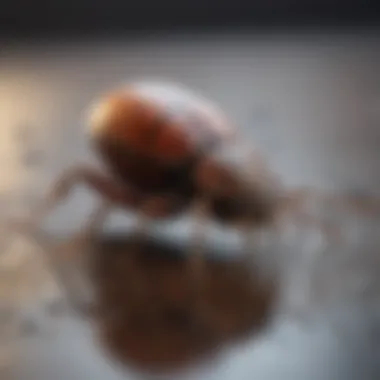Effective Strategies for Managing and Preventing Tick Infestations in Your Home


Overview of the Topic
Ticks are small arachnids that feed on the blood of mammals, birds, and sometimes reptiles. They are not only a nuisance but also pose health risks to humans and pets by transmitting diseases such as Lyme disease and Rocky Mountain spotted fever. Understanding how to effectively deal with ticks in your house is crucial for maintaining a safe and healthy living environment.
Current Status and Challenges
The presence of ticks in homes is a growing concern due to their ability to multiply quickly and carry harmful pathogens. The challenge lies in eradicating these pests entirely, as they can hide in hard-to-reach areas and reproduce rapidly. Additionally, ticks have developed resistance to certain pesticides, making traditional methods less effective.
Sustainable Solutions
Implementing sustainable practices is key to managing ticks in your house. This includes regular inspection of potential hiding spots, such as cracks and crevices, and the use of natural remedies like diatomaceous earth. Integrated pest management strategies, which focus on minimizing pesticide use and promoting natural predators of ticks, offer environmentally friendly solutions.
Impact and Importance
Tick infestations not only affect the health of residents but also have wider implications for ecosystems and communities. By controlling tick populations in homes, we contribute to disease prevention and promote overall well-being. Investing in sustainable tick control measures is vital for safeguarding public health and maintaining a harmonious balance in our living spaces.
Understanding Ticks
Ticks are small arachnids that belong to the order Parasitiformes. Understanding these parasitic creatures is crucial in effectively dealing with infestations in your household. By knowing how ticks behave and thrive, you can implement targeted strategies to eliminate them. Whether you are a homeowner, pet owner, or nature enthusiast, being well-versed in tick identification and behavior is essential for maintaining a healthy living environment. This section will delve into the intricate details of ticks, shedding light on key aspects that are fundamental to addressing infestations.


Identification of Ticks
Identifying ticks accurately is the first step towards combating infestations. Ticks vary in size and color based on their species and life stage. Common species include the deer tick, dog tick, and lone star tick. Adult ticks typically have eight legs, while nymphs and larvae have fewer. Understanding the physical characteristics of different tick species enables you to assess the level of infestation in your home. A magnifying glass can be useful for examining ticks closely, paying attention to distinguishing features such as body shape, color patterns, and mouthparts.
Lifecycle of Ticks
The lifecycle of ticks consists of four stages: egg, larva, nymph, and adult. Each stage plays a crucial role in the survival and reproduction of ticks. Ticks require a blood meal at every stage to advance, making them persistent ectoparasites. Depending on the species, the duration of each stage can vary significantly. Understanding the lifecycle of ticks is vital for implementing targeted control measures at opportune times. For example, focusing on larval and nymphal stages can disrupt the breeding cycle and reduce the overall tick population in your household. By grasping the intricacies of tick development, you can adopt proactive strategies to limit infestations and safeguard your living space.
Signs of a Tick Infestation
Ticks are insidious pests that can pose serious health risks to humans and animals. Understanding the signs of a tick infestation is crucial in maintaining a safe living environment. The presence of ticks in your house can lead to various health issues, including Lyme disease and Rocky Mountain spotted fever. Therefore, early detection and proper management of a tick infestation are essential for safeguarding your family's well-being.
Physical Evidence of Ticks
Identifying physical evidence of ticks in your home is paramount in combating an infestation. Look out for small, dark pests crawling on surfaces or embedded in fabrics. Ticks are often found in warm and humid areas, such as carpets, rugs, and pet bedding. Keep an eye out for tiny blood spots or droppings that indicate the presence of ticks in your living space. Promptly addressing any physical evidence of ticks can help prevent their proliferation and reduce the risk of tick-borne illnesses.
Symptoms of Tick Bites
Recognizing the symptoms of tick bites is crucial for early intervention and treatment. Common signs of a tick bite include redness, swelling, and itching at the bite site. In some cases, ticks can transmit diseases such as Lyme disease or ehrlichiosis, leading to more severe symptoms like fever, fatigue, and joint pain. Stay vigilant for symptoms that persist or worsen after a tick bite, as prompt medical attention is necessary to prevent complications. Educating yourself on the symptoms of tick bites can empower you to take proactive measures to protect your health and well-being.
Preventative Measures


Preventative measures are crucial in the battle against tick infestations. By implementing effective strategies to deter ticks from your house, you can create a safe and healthy environment for your family. These measures not only help in preventing the spread of ticks but also minimize the risks associated with tick bites and related illnesses. Proper preventative measures involve a combination of cleanliness practices, outdoor environment management, and the use of natural repellents. By adopting a holistic approach, you can significantly reduce the likelihood of encountering ticks within your living space.
Maintaining Cleanliness
Maintaining cleanliness is a fundamental aspect of tick control. Regular cleaning routines, including vacuuming, dusting, and decluttering, help eliminate potential hiding spots for ticks. Paying attention to areas such as baseboards, carpets, and upholstery is essential, as ticks often seek refuge in these secluded locations. Keeping your living space tidy and well-maintained not only deters ticks but also minimizes their breeding grounds, thereby reducing the overall tick population in your house.
Outdoor Environment Management
Managing your outdoor environment plays a critical role in preventing ticks from entering your home. Ensure that your yard is well-maintained by keeping grass trimmed, removing leaf litter, and creating barriers to prevent wildlife from entering your property. Implementing landscaping features such as gravel or wood chips as borders can act as a natural deterrent for ticks. Additionally, consider using eco-friendly pesticides or tick tubes in outdoor areas to control tick populations effectively.
Use of Natural Repellents
Natural repellents offer a safe and environmentally friendly way to repel ticks from your house. Essential oils such as lavender, eucalyptus, and citronella are known for their tick-repelling properties. By strategically placing essential oil diffusers or sachets in key areas, you can create a hostile environment for ticks. Planting tick-repelling plants like marigolds and chrysanthemums in your garden can also help deter ticks naturally. Incorporating these natural repellents into your tick control regimen provides an added layer of protection against tick infestations.
Effective Treatment Options
In the realm of tick infestations, the crucial aspect of effective treatment options cannot be overstated. This section delves into essential methodologies and strategies to combat and eradicate ticks from your household, ensuring a safe and healthy environment for you and your family. Natural remedies and professional pest control services play pivotal roles in addressing and preventing tick infestations.
Natural Remedies for Ticks


Natural remedies for ticks offer a sustainable and environmentally friendly approach to tackle these troublesome pests. By leveraging natural ingredients such as essential oils, diatomaceous earth, or vinegar, you can effectively repel and eliminate ticks from your living spaces. These remedies are not only safe for your family and pets but also help in maintaining a chemical-free home environment.
Professional Pest Control Services
When facing severe tick infestations or persistent problems, enlisting the expertise of professional pest control services becomes imperative. Trained professionals can conduct thorough inspections, implement targeted treatment plans, and provide ongoing monitoring to ensure effective tick removal and control. By choosing reputable pest control services, you can benefit from tailored solutions and expert guidance in safeguarding your home against tick infestations.
Additional Tips and Considerations
As we delve deeper into the realm of tick control, it is paramount to consider additional tips and considerations to fortify our defense against these menacing parasites. These supplementary measures serve as the crucial final layer in the protection of our households, ensuring a comprehensive strategy for keeping ticks at bay. By incorporating these tips into our regular routine, we can significantly reduce the risk of tick infestations and safeguard the well-being of our loved ones.
Regular Pet Inspections
One of the primary avenues through which ticks enter our homes is through our furry companions. Regular pet inspections are essential to detect any lurking ticks on our pets' fur before they have the chance to migrate indoors. By conducting thorough inspections after outdoor activities and grooming sessions, pet owners can nip tick infestations in the bud. Pay close attention to areas where ticks are likely to hide, such as under the collar, in the armpits, and around the ears. Prompt removal of any ticks found on pets can prevent them from infesting your home and posing a threat to your family.
Consultation with Veterinarian
Seeking guidance from a veterinarian can provide valuable insights into effective tick prevention and control strategies tailored to your pets' specific needs. Veterinarians can recommend suitable tick prevention products, such as topical treatments or collars, based on your pets' size, breed, and lifestyle. Additionally, veterinarians can offer advice on safe tick removal techniques and how to monitor pets for signs of tick-borne illnesses. Regular check-ups with a veterinarian can contribute significantly to maintaining a tick-free environment and ensuring the health and well-being of your pets.
Monitoring and Surveillance
Continuous vigilance is key to keeping tick infestations in check. Implementing a monitoring and surveillance routine can help track any potential signs of ticks within your home environment. This involves regularly inspecting high-risk areas, such as pet bedding, carpets, and dark corners, for any indications of tick presence. Consider setting up sticky traps or using specialized tick detection tools to monitor tick activity. By staying proactive and attentive to changes in your surroundings, you can detect and address tick infestations early, preventing them from escalating into a larger problem.
Conclusion
Maintaining a Tick-Free Household
When it comes to maintaining a tick-free household, vigilance and consistency are key. Regularly inspecting pets for ticks after outdoor activities is essential in preventing these pests from entering your home. It is crucial to consult with a veterinarian for guidance on tick prevention and treatment, as they can provide tailored advice based on your pet's specific needs. Additionally, incorporating monitoring and surveillance measures in and around your home can help detect any potential tick infestations early on. By staying informed and proactive, you can effectively protect your household from the hazards associated with ticks, ensuring a safe and comfortable living environment for all.



